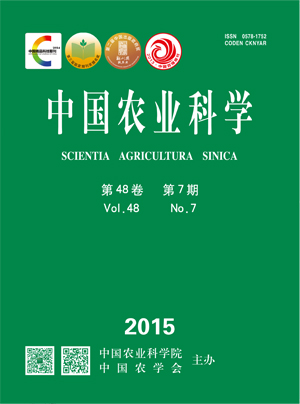【Objective】The objective of this experiment is to study the roles of no apical meristem (NAM) transcription factors Gpc-1 and Gpc-2 in early senescence and nutrient remobilization to the grain of bread wheat. 【Method】 Their spatiotemporal expression patterns were investigated during the grain-filling stage in wheat cultivar Chinese Spring. Their temporal expression dynamics were studied in penultimate leaf, flag leaf, peduncle, glume, rachis and the kernel using quantitative real time polymerase chain reaction (qRT-PCR). And the relative expression level was quantified using Pfaffl method with normalization against multiple verified reference genes. Applying mRNA in situ hybridization, the spatial expression pattern was explored in post-anthesis flag leaf, peduncle and the kernel only with digoxin-labeled oligonucleotide probes which were specifically targeting 5′ or 3′ untranslated regions (UTRs) of Gpc-1 and Gpc-2. 【Result】 Contrary to a previous report, the functional TaNAM-B1 rather than its dysfunctional paralog was found in Chinese Spring, and its nucleotide sequence was identical with the wild-type TtNAM-B1 in T. turgidum TaNAM-B2 and TaNAM-A1 were the highest in flag leaf among five NAM genes.TaNAM-A1, TaNAM-B1, TaNAM-B2 and TaNAM-D2 were expressed in all studied tissues before anthesis, whereas TaNAM-D1 was expressed only since the ?rst-?owering date. TaNAM-A1 exhibited the distinct expression patterns among the tissues. Its transcript abundance began to decline in penultimate leaf, rachis and the kernel at 15 DAA, which was preceded that in flag leaf (25 DAA) and other tissues. The transcription levels of TaNAM-B1 and TaNAM-D2 kept increasing till the late filling stage (25 DAA or 30 DAA) in most organisms except for advanced declines of TaNAM-B1 and TaNAM-D2 in the grain and the glume, respectively.(25 DAA) and the peduncle (20 DAA). Unlike other genes, a consistent growth until 25 DAA and 30DAA in transcript abundance of TaNAM-D1 was observed. 【Conclusion】 In conclusion, Gpc-1 and Gpc-2were closely associated with mineral translocation in the grain; however, no obvious relationship between five NAM genes and the PCD in wheat grain was observed. And the discrepant temporal expression dynamics suggested that their functions were not identical. In addition, the potential effect of these genes on senescence in vegetative tissues was still elusive. Combined with previous findings, it was proposed that Gpc-1 and Gpc-2 may directly regulate nutrient remobilization only or in parallel with the senescence during grain filling. The expression level of TaNAM-B2 decreased from 15DAA in most tested tissues other than the flag leaf var.dicoccoides. All the results showed that Gpc-1 and Gpc-2 were all widely expressed in studied tissues with the exception of the root in which only the transcript of Gpc-1was detected. The outcomes of mRNA in situ hybridization indicated that all five genes shared cell-type specificities. To be specific, no transcripts were distributed in leaf epidermal cells, pericarp and the seed coat; however, they mainly aggregated in leaf mesophyll cells, aleurone layer, embryo, and the tissues responsible for the mineral element transport (vascular bundle, pigment strand, nucellar projection and the transfer cell) in grain, in which the highest expression level was observed in embryo. In addition, lower expression level was detected in the peduncle and leaf vascular bundle as well. The results of qRT-PCR showed that the temporal expression dynamics of Gpc-1 and Gpc-2 differed upon the organs and the genes. According to the Ct value, TaNAM-D2 was expressed less than other genes in all tested tissues. And the most abundant gene in wheat kernel was TaNAM-D1,whereas that in peduncle, glume and the rachis was TaNAM-B2. Besides, the expression levels of









